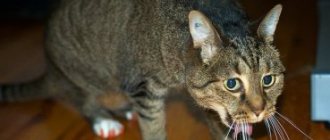Causes of blood in stool
There can be many reasons why blood appears in a cat's stool. Almost all of them are associated with disruption of the gastrointestinal tract. In most cases, only a doctor can make an accurate diagnosis.
Constipation
Constipation is common in cats. Most often it appears due to improper feeding of the animal. The stool becomes very hard. As they pass through the intestines, they damage its walls, which is why blood can be found in the stool.
In addition, during defecation, if the animal has to strain a lot, which can cause anal fissures.
If an animal cannot go to the toilet for a long time, and during defecation it meows pitifully, this may indicate constipation. This problem should not be ignored, as frequent constipation can lead to the formation of fecal impaction or intestinal prolapse.
You might be interested in: Poisonous plants for cats: how to help with poisoning?
Tumor
Benign or malignant neoplasms may appear on the intestinal walls, which in some cases leads to bleeding. It is worth noting that a benign neoplasm can be no less dangerous than a malignant one. If it quickly increases in size, it can soon completely block the intestines. Intoxication of the body will begin, vomiting will appear, and the body temperature will rise significantly. Without immediate assistance, the animal can die very quickly.
Poisoning
Cats that have unhindered access to the outdoors are most often susceptible to poisoning. Heavy bleeding from the anus is one of the symptoms of rat poison poisoning. A cat may eat a poisoned animal or bait. In case of poisoning, the following symptoms are also observed: a significant increase in body temperature, profuse vomiting, diarrhea.
Injuries
Bleeding in the intestines can occur due to trauma to the abdominal cavity. Internal bleeding may occur if there is a strong impact (for example, if a cat is hit by a car), or if it falls from a high height. In addition, swallowed sharp objects (bone fragments, blades, needles) can damage the intestinal mucosa. Internal bleeding is an extremely dangerous condition in which the animal must be immediately shown to a doctor.
Parasites
With a strong parasitic infestation, all internal organs are affected. Eventually, worms can infest the intestines. This often leads to disruption of the gastrointestinal tract. Blood may appear in the stool. In addition, worms can be found in it. The cat suddenly loses weight, its appetite decreases or, on the contrary, increases, and anemia is observed. Complete blockage of the intestines is possible. This is why it is so important to prevent helminth infection.
Protozoan infestations can also lead to blood in the stool. In addition, the cat experiences severe dehydration and exhaustion, the animal becomes passive and shows no interest in anything.
Malnutrition and feed changes
Improper and unbalanced nutrition is one of the most common causes of disruption of the gastrointestinal tract. This often leads to constipation or diarrhea.
Low-quality food contains harmful additives, is poorly balanced and does not include sufficient vitamins and minerals.
In addition, when feeding dry food, it is very important that the animal always has free access to drinking water. Lack of fluid in the body leads to constipation. A sudden change in food can also cause blood to appear in your cat's stool. New foods must be introduced into the diet gradually. In addition, it should be noted that some cats may not react in the best way even to good food. Therefore, you need to carefully select a diet for your pet, taking into account all its features.
Caution should also be exercised when feeding natural foods. There are a number of foods that should be completely excluded from the diet:
- smoked meats and pickles;
- potatoes and legumes;
- sweets;
- tubular chicken bones (often cause injuries to the pharynx and intestines);
- all types of seasonings.
Inflammation of the paraanal glands
Not far from the anus are the paraanal glands, through which cats secrete a special odorous secretion. With the help of these glands, cats mark their territory. Sometimes these glands become clogged, which causes pus to accumulate in them and can even secrete blood, which ends up in the stool during bowel movements. The animal crawls with its butt on the floor and often licks itself under its tail. Inflammation and redness can be seen near the anus.
Intestinal blockage from hairballs
While licking, cats absorb large amounts of their own hair. In the stomach, the fur rolls up and mixes with digested food. In most cases, cats cleanse their bodies themselves. But sometimes these lumps enter the intestines, which leads to disruption of the gastrointestinal tract. Long-haired breeds especially often suffer from this problem. In the most advanced cases, surgery may be required.
You might be interested in: Why do wounds appear on a cat’s tail?
Gastrointestinal diseases
Various chronic diseases of the stomach and intestines can lead to defecation disorders. Colitis, an inflammation of the intestinal walls, often leads to bleeding. It is most often found in older animals. With this disease, constipation and diarrhea alternate. In addition to blood, stool contains mucus.
Infection
There are a number of infectious diseases that can lead to blood in the stool. Among them are: panleukopenia, leukemia, viral immunodeficiency, coronavirus. The main symptoms of a viral disease: increased body temperature, fever, diarrhea with blood.
Bleeding disorder
With this diagnosis, any damage is accompanied by increased bleeding. Blood can be in both stool and urine. Other symptoms: bleeding from the nose and gums, into the sclera of the eye. Even a small injury can lead to severe bleeding. A blood clotting disorder is possible when a cat is poisoned with rat poison.
Treatment with antibiotics or other drugs
In some cases, blood in the stool may appear during treatment of the animal with potent drugs. Taking antibiotics can lead to disruption of the gastrointestinal tract. If blood is detected in the stool, you should consult a doctor. He may change the course of treatment, or prescribe medications that should support the functioning of the gastrointestinal tract while taking the medication.
bleeding from the cat's anus
Treatment is selected depending on what the veterinarian must determine. If these are worms, then it is necessary to give the animal anthelmintic drugs according to a specific regimen prescribed by the doctor. You also need to review your cat’s diet and avoid giving it raw fish and meat.
Meat should be either boiled or frozen, and it is better to exclude fish from the diet altogether or give some sea fish.
Inflammation of the rectum is treated with a solution of tannin, a solution of copper sulfate, and the introduction of tampons with ointment into the posterior
Attention to the animal under care must be complete: observation of behavior, its changes, the condition of the coat, eyes, ears, limbs, genitals and anus. You can often see dried droplets of blood with pieces of feces under the tail. The sight is unpleasant, but even more alarming.
Treatment options
The first thing you need to do is go to the veterinary clinic. There they will conduct a diagnosis and identify the cause of bleeding from the cat’s anus. The doctor will prescribe treatment and give advice on feeding the animal. To make a diagnosis, a stool test is performed and, if necessary, a colonoscopy.
If your pet is infected with parasites, then it is not scary. It can be cured by adjusting the diet and an anthelmintic drug prescribed by a veterinarian. These measures will remove worms from your pet's intestines. The diet is also changed in case of allergies.
If a cat is bleeding from the anus due to an infection, treatment should be carried out with antibiotics. In colitis, the animal's stool contains bloody mucus. It is treated with suppositories, ointment, tannin, and copper sulfate solution. The disease has several forms, so you cannot treat the cat yourself.
Cats may develop thromboembolism. This is a disease in which blood clots and blood clots form. It can develop rapidly. Manifested by diarrhea with blood clots. Usually the prognosis is not favorable. But if detected at the onset stage, it will give the cat a chance to live. Blood from the anus can signal the appearance of a tumor. It can be benign or malignant. It is very difficult to diagnose, especially if the tumor is small. The doctor does not always make the correct diagnosis. To check, it is recommended to do an ultrasound.
© shutterstock
Due to intestinal problems: diarrhea, constipation, the mucous membrane is injured and cracks may occur. They can be complicated by hemorrhoids. As feces pass through, they become inflamed. They hurt and bleed. In this case, blood from the anus appears after bowel movement. At an early stage it is treated with suppositories and ointments.
The appearance of blood in a cat's stool may be accompanied by other symptoms. You also need to pay attention to them in order to make a correct diagnosis.
- The animal began to pee frequently;
- Vomit;
- The cat refuses to eat or eats very little;
- The animal is rapidly losing weight;
- Thirst;
- Lethargy, lack of usual interest in the environment.
In order to find the cause of the bleeding in time and not cause a deterioration in the animal’s condition, you need to contact a veterinarian. A timely diagnosis gives a better chance of recovery. You can’t put it off and risk your cat’s health.
The cause of bleeding is inflammation of the paraanal glands.
Inflammation of the paraanal glands If your pet is bleeding from the butt, it is possible that his paraanal glands are inflamed - paired exocrine glands that secrete a special odorous substance with which cats mark territory and attract members of the opposite sex. They also take part in metabolic processes in the animal’s body. The ducts clear themselves during bowel movements. Sometimes they become inflamed. Causes of inflammation of the paraanal glands in cats:
- poor nutrition;
- overweight;
- injury to the anus;
- worms;
- low physical activity.
The problem can be recognized by the following signs:
- biting the base of the tail and pressing it against the sphincter;
- rubbing the anus on the floor;
- limping or lifting of the hind leg when walking;
- constant unpleasant odor;
- swelling of the anus;
- deterioration in general health and appetite.
The inflammatory process may be accompanied by an increase in body temperature. However, this does not happen in all cases.
Diagnosis and treatment
Blood in the stool can indicate a wide range of diseases. That’s why you shouldn’t self-medicate or ignore the problem altogether. Only a doctor can make an accurate diagnosis after conducting a series of studies.
First, the veterinarian will interview the owner. It is necessary to talk about whether the cat has any other symptoms of the disease, describe the pet’s diet, does the cat have access to household chemicals or other items that it could swallow, has it previously had diarrhea or constipation, has it cleaned The cat's stomach has been affected by fur lately.
First of all, the doctor will take stool for analysis. Using a microscope, he will be able to eliminate the possibility of parasitic infestation. A general blood test can indicate the presence of any inflammatory processes in the animal’s body, or anemia. In addition, blood should be examined for clotting.
A general urine test will help determine whether there are inflammatory processes in the kidneys. With the help of palpation, you can determine the presence of anal fissures and tumors, and assess the condition of the paraanal glands.
An ultrasound of the abdominal area will help to see the inflammatory processes occurring in the internal organs. X-rays (including the use of contrast) will help detect foreign objects in the intestines.
In some cases, endoscopy is necessary to make an accurate diagnosis. The same method can eliminate minor bleeding in the intestines and take tissue for analysis. The procedure is performed under anesthesia.
Treatment directly depends on the diagnosis.
- If the cause is parasitic infestation, the cat is given anthelmintics. Moreover, the medicine must be given several times with an interval of 10 days until all the helminths leave the body along with the feces.
- For infectious diseases, a course of antibiotics is prescribed. You may also have to give your animal anti-inflammatory and painkillers.
- When there is an intestinal blockage, the animal is first given castor oil or given an enema. If the stuck object is too large, surgical intervention is prescribed. Surgery is also prescribed in case of tumors appearing on the intestinal walls. Surgery is especially important if the tumors are growing.
- When the anal glands become inflamed, the doctor cleans the clogged pores and removes all the accumulated pus.
- If anal fissures occur, special suppositories with sea buckthorn oil are prescribed. The owner can administer the suppositories himself 2 times a day. In this case, the animal must be held in your arms for about ten minutes until the candle melts.
- In case of poisoning, the cat's stomach is cleansed and medications are given that remove toxins from the animal's body. If there is excessive vomiting and dehydration, the animal is given a drip.
- If you experience frequent constipation, your doctor will prescribe a special diet. You can add food to your diet that is intended for animals with gastrointestinal disorders. In some cases, dry food is completely removed from the diet, replacing it with canned food or natural food.
You may be interested in: Chlamydia in cats: routes of infection, symptoms, treatment of infection
Diagnostics
To understand what disease you are dealing with, you will have to undergo a series of examinations. The veterinarian will immediately take a blood test to see what condition the body is in. Additionally, urine and stool examination may be required. If the doctor deems it necessary, then he will send the animal for an ultrasound or x-ray.
Based on the research results, conclusions can be drawn about the animal’s well-being. If a disease is detected, then therapy will have to be started immediately.
What should you do if you notice blood under your cat’s tail?
When a cat bleeds from the anus, this is a serious problem that requires immediate attention. The same applies to bloody vaginal discharge not associated with estrus or the postpartum period.
Under no circumstances should you self-medicate or expect it to go away on its own.
The animal should be taken to a veterinary clinic. The specialist will conduct an examination and prescribe a diagnostic test.
examination.
A cat with bleeding should undergo the following types of diagnostics:
- Blood analysis.
- Urine and stool analysis.
- Ultrasound of the abdominal cavity and genitourinary system.
- Radiography.
In severe cases, surgery may be necessary. When there is no threat to life, the cat is prescribed medication. For diseases of the gastrointestinal tract and kidneys, you will need a special diet.
As a preventive measure, it is recommended to carefully monitor your pet’s diet, treat emerging diseases in a timely manner, and undergo regular examinations by a veterinarian.
Infection with worms
Worm infestation is a fairly common cause of bleeding from the anus in these animals. No cat is immune from parasite infection. Pets who are outdoors and cats whose owners do not care about protecting their four-legged pets from worms are especially at risk. Having penetrated the animal's body, the worms attach to the walls of the small intestine and damage them, which leads to bleeding. Blood comes out along with the stool.
Parasitic infections are dangerous to the health of these animals, but extremely rarely lead to their death. Usually, owners of cats infected with parasites take timely measures to eliminate worms. Their treatment involves the use of antiparasitic veterinary drugs. It is recommended to give the same drugs to pets once every 3 months as a prophylactic measure.
What is pancreatitis?
What are the symptoms of the disease? The most typical sign of inflammation of the rectum is frequent acts of defecation, during which the animal strains strongly. Feces are released in very small portions, and when defecating, the pet experiences severe pain. Feces often become mucous, acquire a dirty brown or greenish tint, and blood is constantly found in them.
If the animal is not provided with medical care, the development of the pathological process leads to desquamation of the mucous membrane and damage to the deep layers of the rectum. In this case, pathogenic and conditionally pathogenic microflora can enter directly into the blood, resulting in sepsis. As a result, the pet’s general condition deteriorates sharply, the pet stops eating, and exhaustion develops.
We suggest you read: How to properly make friends between two cats in the same apartment
There are many possible reasons for the development of this disease. The most typical are: intestinal parasites, bacterial infections, mycoses, as well as poisoning from drugs and household chemicals. In addition, proctitis is fraught with accidental ingestion of foreign bodies, since they often lead to injury to the mucous membranes of the intestines, as a result of which pathogenic and conditionally pathogenic microflora begin to develop there.
Sometimes the pathology develops as a result of autoimmune diseases. These are the most difficult and most unobvious situations, since such pathologies are difficult to diagnose and even more difficult to treat. In addition, the signs of these ailments develop over a long period of time, sometimes several years.
Owners do not notice that something wrong is happening with their pet’s health, which is why they turn to the veterinarian when it is too late. In addition, proctitis is a common consequence of uremia, a phenomenon in which many nitrogenous bases appear in the blood. This often happens due to diseases of the genitourinary system. Of course, inflammation of the rectum is a trifle, since other consequences of uremia are much more severe.
An inflamed bowel may also be an indicator of damage to other internal organs. For example, with pancreatitis, that is, inflammation of the pancreas, a similar outcome is quite likely. Inflammatory diseases or immunological disorders, poor quality nutrition and constant stress are all quite common causes of rectal diseases, and not only proctitis.
Unfortunately, many owners forget that allergic reactions can also be an important predisposing factor in any inflammatory diseases. If your pet is predisposed to such pathologies, it is important to provide it with special food that is completely free of substances that may be allergens.
Unfortunately, in these animals, pancreatitis very often becomes chronic. Feline pancreatitis is less acute than in dogs, but lasts longer. In some cases, when the disease gets out of control, it can affect not only the gastrointestinal tract, but also other parts of the body. For example, the respiratory system may be significantly affected.
Pancreatitis is a very serious disease, and if a pet owner sees blood from a cat's anus, he should immediately take the animal to the veterinarian.
What can cause a cat to bleed from under its tail? In the vast majority of cases, it is pancreatitis, a very common gastrointestinal disorder in pets. Previously, scientists believed that cats were much less susceptible to this disease than dogs, but the latest research suggests the opposite.
Unfortunately, in most cases, pancreatitis in a cat goes undetected until obvious signs of the disease appear.
Unfortunately, in these animals, pancreatitis very often becomes chronic. Feline pancreatitis is less acute than in dogs, but lasts longer. In some cases, when the disease gets out of control, it can affect not only the gastrointestinal tract, but also other parts of the body. For example, the respiratory system may be significantly affected.
Pancreatitis is a very serious disease, and if a pet owner sees blood from a cat's anus, he should immediately take the animal to the veterinarian.
Has been a problem for many decades. The main difficulty is that the disease cannot be diagnosed based on clinical signs alone, since lethargy, lack of appetite, dehydration, vomiting and diarrhea are signs of many other diseases that are in no way related to pancreatitis.
Another factor that greatly complicates the detection of the disease is that pancreatitis almost always occurs in parallel with some other ailment (most often associated with liver disease).
Several years ago, a new examination method was developed and introduced, which makes it possible to clearly understand how well the pancreas produces digestive enzymes and in what quantities they enter the stomach.
We invite you to familiarize yourself with: East European Shepherd VEO
There is another very high-quality test that allows you to understand more about the condition of the animal’s pancreas. Its name is pancreatic immunoreactivity testing. As experimental and clinical experiments have shown, the test very well demonstrates the presence or absence of an inflammatory process in the cat’s pancreas. It is carried out in the form of a routine blood test.
Rectal injuries
Bleeding from the rectum in these animals is accompanied by staining of the stool with scarlet blood. The most common cause of this phenomenon is damage to the mucous membrane of the organ by too hard feces, which contain the remains of incompletely digested food, hair that got into the stomach during licking, and bone fragments. In older pets, this problem can arise as a result of various pathologies of the rectum (for example, prolapse, cracks, malignant neoplasms).
Poor quality feed
Economy segment feeds cause serious harm to the gastrointestinal tract of the animal. The result of using low-quality feed can be vomiting and constipation in the animal, problems with the liver and gall bladder, and blood from the cat’s anus. To avoid such problems, you should buy only expensive, high-quality food recommended by veterinarians. Water should be freely available to the animal. Sometimes the diet should be diluted with wet food from the same company as dry food.
You should be careful when feeding natural food. Raw fish and meat can lead to parasite infestation. Constant feeding of fish leads to problems with the liver and gall bladder, which later affects the intestines. Many owners feed their cats tubular chicken bones. This should not be done under any circumstances!
Chicken bone fragments are very sharp, they can easily rip a cat's throat. In addition, they can accumulate in the stomach and injure it or damage the intestines. When feeding natural food, it is important to properly balance the diet. It should contain meat and grains, and the cat should also receive vitamin and mineral supplements.
Tumor formations in the intestines
The appearance of blood from the pet's anus is one of the symptoms of neoplasms in the intestines. Such tumors are rarely diagnosed in cats and often have a poor prognosis. The sooner the cat's owner seeks veterinary help, the higher the likelihood of successful treatment of the animal. The causes of this disease are not fully understood. In the course of research, it was possible to establish that representatives of the Siamese breed have a predisposition to intestinal cancer.
Possible reasons
The reasons why a cat bleeds from under its tail are quite varied. One of the main reasons is the onset of sexual heat or estrus (heat). Estrus is a physiological process in the body of a healthy cat that occurs in the appropriate period.
The beginning of estrus is a kind of signal that the animal is ready for mating and further procreation. The appearance of blood in small quantities released from the area of the pet's loop is not dangerous, but indicates puberty.
In addition to physiological ones, there are a number of other reasons why a cat bleeds from under its tail. The main ones are:
- Inflammatory pathological processes in the gastrointestinal tract. The nature and extent of the lesions can only be determined after a thorough examination in a veterinary clinic using special equipment and tests. The appearance of blood under the tail in some cases is a symptom of tumor processes in the rectum, damage to the large intestine, or trauma to the paraanal glands.
- Bleeding in the loop area is possible due to damage to the uterine arteries. Occurs with inflammation of the endometrium, neoplasms of a malignant and benign nature, pyometra. In addition to blood under the tail, the animal experiences general weakness, apathy, and increased body temperature. It all depends on the degree of the pathological process.
- Spontaneous termination of pregnancy. Natural abortion is more often diagnosed in the early stages of gestation, so that the owner sometimes does not notice dramatic changes in the pet’s behavior. The cat, being a naturally clean creature, constantly licks the loop area, removing secretions. Kittens that die in the womb do not always emerge completely from the uterine cavity, and inflammation processes are accompanied by the release of large amounts of blood. In some cases, when the pathology is neglected, purulent discharge appears.
- Uterine bleeding due to mechanical injuries. As a result of injury to the large uterine arteries, the cat drips blood from under its tail, and the general condition of the animal deteriorates sharply. Large blood loss can be fatal in the absence of proper care.
- Formation of stones in the genitourinary system. The development of urolithiasis occurs in representatives of domestic cats often in the clinical practice of veterinarians. The disease progresses with violations of the diet and consumption of drinking water that has high hardness. The release of stones provokes trauma to the mucous membrane and bleeding. The condition of an animal with urolithiasis requires immediate intervention by a veterinary specialist.
Infectious diseases
This problem can be caused by a number of infectious diseases: rotavirus, parvovirus, coronavirus enteritis, which is most often detected in kittens, panleukopenia, salmonellosis, campylobacteriosis, intestinal tuberculosis, colibacillosis, etc. In addition to bleeding from the anus, these diseases are accompanied by other symptoms, such as fever, vomiting, dehydration of the body, loss of appetite, deterioration in general health.
What kind of bleeding can there be?
Bleeding is classified not only depending on its cause and the damaged vessel, but also on the abundance, location of the effusion and some other criteria.
Bleeding is usually divided into:
- by origin: pathological (caused by disease), traumatic;
- by place of discharge: external, internal;
- by degree of expression: hidden, obvious;
- by severity: mild, moderate, severe, massive, lethal;
- according to the vessel that was damaged: capillary, venous, arterial, parenchymal (if organ tissue is damaged), mixed.
Based on the time of occurrence of bleeding, it is also customary to divide it into primary, which opens immediately after damage to the vascular wall, and secondary (early and late). Early - occur after bleeding stops (most often within the first 5 days). Late ones arise due to the destruction of the vessel wall and are difficult to stop.
Most often in cats, owners observe post-traumatic bleeding or post-traumatic bleeding of varying degrees of severity.
Internal bleeding into the cavity of the pleura or cardiac sac, into the joint cavity is almost impossible to recognize without special methods.
Chronic colitis
If your pet is bleeding from the anus, his colon may be inflamed. The main signs of chronic colitis, characterized by extensive damage to the digestive tract, frequent relapses and a long course:
- unformed stool with a foul odor and inclusions of mucus and blood;
- increased bowel movements and decreased amount of stool;
- rumbling, bloating and abdominal pain.
The danger of this disease is that affected animals usually appear generally healthy: they eat as usual and maintain a constant body weight. When the pathological process worsens, the pet begins to vomit, body temperature rises and weight decreases.
Causes of blood
Discharge of blood from a cat's anus is not a typical phenomenon; it indicates an illness in the animal. It can be caused by various reasons:
- With constipation, blood appears due to damage to the intestines. It is released in small quantities during bowel movements. You need to give your cat a remedy for constipation and lubricate the anus with Vaseline, oil or soap. If there is no blood when the animal goes to the toilet again, then it is not necessary to consult a doctor.
- If blood in the feces is a regular occurrence, then this indicates a serious problem with the cat’s health; in order to treat your pet, you need to find the reason why the disease appeared. The main causes of blood in a cat identified by veterinarians are as follows:
- Allergy;
- Colitis;
- Parasites;
- Pancreatitis;
- Tumor;
- Poisoning;
- Damage to the intestines or anus;
- Thromboembolism.
Therapeutic techniques
If your cat becomes dehydrated from chronic diarrhea, she will need to be hospitalized for intravenous rehydration. When the inflammation is particularly severe, the animal must be put on a starvation diet for 24-48 hours,
since the rectum needs time to restore the epithelial layer. Meanwhile, if chronic inflammation and scar tissue have formed in the colon, such simple techniques will no longer help. A surgical operation will be required, during which the affected areas of the organ will be cut out. It should be noted that with proctitis of fungal etiology, surgery is most often required, since pathogenic fungi greatly destroy the tissue of the affected organ.
Do you have a kitten in your house? This is real happiness, because he is so small, touching and defenseless. Unfortunately, a kitten is even more susceptible to various infections and diseases than an adult animal. One of the most obvious signs of many of them is the presence of blood in the stool.
How to clean the glands yourself?
When there is no way to get your animal to a veterinarian or call him home, you can try to clean the glands yourself.
Before the procedure, it is advisable to change into old clothes, or even better, put on a protective robe and put on glasses. The manipulations themselves are carried out in the bathroom. The fact is that during cleaning, the secretion, which smells very unpleasant, is splashed in all directions and the chance of being smeared is very high.
Method No. 1
Cleaning is carried out with an assistant who can securely fix the cat. Fixation is carried out using an ordinary diaper, sheet or towel, in which the poor fellow is wrapped, leaving only the tail exposed (the hind legs are also hidden, otherwise there is a chance of being seriously injured).
Further steps consist of squeezing the anus between the thumb and forefinger using a paper napkin. Naturally, gloves are first put on. Gently press on the glands (located at approximately 5 and 8 o'clock on either side of the anus) until fluid appears.
After cleaning, an anti-inflammatory rectal suppository is inserted into the anus. If there are good reasons for this, then the cleansing measures are repeated over time.
Method number 2
It is clear that the above technique will only help in case of slight enlargement of the glands. When the secretion is too viscous, they resort to a more complex and rather painful option for emptying the anal sacs.
Again, fix the pet, put on gloves, lubricate the finger with Vaseline and carefully insert it into the anus:
Method number 3
It is logical that not all owners are mentally prepared for this procedure, so you can resort to another method, which in not very complex and advanced cases turns out to be quite effective:
- the anus and surrounding tissues are lubricated with ointment containing syntomycin or any other anti-inflammatory agent;
- a collar is put on the animal to prevent it from licking the anus;
- At night, a suppository with ichthyol is inserted (the frequency of administration is 10 days). It is important that the cat does not run to the toilet after this, so they clamp the anus with their fingers for a few minutes, thereby fixing the candle inside.
Inflammation of the pancreas
Bleeding from the anus in a cat can be caused by pancreatitis, which develops due to cholelithiasis, pathologies of the duodenum, infections, malnutrition, helminthic infestation, etc. This disease can be recognized by the following signs:
- abdominal pain that gets worse when eating;
- “idle” urge to vomit;
- complete or partial loss of interest in food;
- belching;
- excessive accumulation of gases in the intestines;
- constipation alternating with diarrhea;
- yellowness of the skin and mucous membranes.
In advanced cases, severe disturbances of carbohydrate metabolism join the pathological process. If this happens, it is unlikely that you will be able to avoid developing diabetes.
Infections
Some infectious diseases can cause bleeding from a cat's anus. Most often they are accompanied by high body temperature, lethargy and refusal to eat, cough, and drowsiness. Bacterial infections are very dangerous for the animal and can be fatal. To accurately determine the cause of your pet’s illness, you must show it to a doctor.
Thus, we have listed the main causes of blood from a cat’s anus. Only a doctor can determine exactly why this happens. If you notice bloody discharge from the anus or blood in the animal's stool, the cat should be taken to the vet immediately.
What do we have to do?
If your cat is bleeding, you don’t need to agonize over what to do. It is necessary to immediately take the animal to the veterinarian. The specialist will conduct a visual examination and collect anamnesis. The owner will have to talk about the pet’s diet, when blood appears in the stool and other symptoms.
Be sure to inform your doctor about changes in behavior: anxiety during bowel movements, tension, fussiness, etc. If the cat refuses to eat or drink or vomits, tell the veterinarian about this too.
For diagnosis, blood and stool tests are prescribed for helminths and occult blood. The most informative thing is a coprogram. With its help you can study the composition of feces. Sometimes an additional urine test is performed.
What to pay attention to
If blood is detected in your pet’s stool, do not immediately panic. Droplets of blood in the excrement may appear due to trauma to the anus during defecation. This is possible if the stool was very hard. The symptom is unpleasant and may indicate a problem with the gastrointestinal tract. But in this case, immediate consultation with a doctor is not required.
You should take your cat to the vet immediately if:
- There is a lot of blood in the stool, red puddles form on the filler.
- Blood in the stool is constantly observed.
- The animal has severe constipation, or vice versa, diarrhea.
- Body temperature is greatly increased.
- There is a decline in activity and apathy.
- Severe vomiting.
- The stool also contains particles of undigested food or mucus.
It is worth noting that red blood in the stool appears when there are problems in the lower intestine. If the functioning of the upper section is disrupted, the feces will be black. So if you find black feces, you should also pay close attention to the health of your pet. Black stool also indicates bleeding in the intestines. If there are no other symptoms of the animal’s disease, then the pet should be observed for some time.
Please note the following:
- Does blood appear in stool again?
- How does the cat behave during defecation: perhaps meowing, experiencing discomfort.
- Is the anus inflamed? Is the cat licking it?
- Has the food changed recently?
- Is drinking water always freely available?
- When was preventive deworming carried out?
- When was the last time a cat cleaned its stomach of fur?
- Could the animal have eaten something unsuitable for food, for example, a poisonous plant?
Causes of bleeding in cats
There are many reasons explaining this condition.
Pyometra
In cats, bleeding from the vagina is a frequent companion to a disease such as pyometra. The development of this disease is most often provoked by an excess amount of progesterone in the cat’s body, which is produced in the following cases:
- uncontrolled use of hormonal contraceptives to prevent pregnancy;
- poor hygiene during estrus;
- violation of sanitary standards during childbirth;
- uncontrolled matings;
- impaired immunity, congenital hormonal changes;
- lack of physical activity.
Those at risk most often are elderly, nulliparous, pregnant cats with pathologies, including those who gave birth prematurely.
A cat with pyometra suffers a lot of pain
Endometritis
Endometritis is an inflammation of the walls of the uterus, often accompanied by a purulent process that further damages the organ, which provokes uterine bleeding. The greatest danger is the development of the disease in the postpartum period, when the uterine tissue has not yet recovered, and the slightest damage leads to copious bloody discharge from the cat’s uterus.
Note! It is recommended to sterilize the young female to prevent the development of endometritis and pyometra.
Causes of bleeding most often diagnosed by veterinarians
Usually, bloody discharge from the anus in cats frightens owners of furry pets, since this is not a typical occurrence. At the first signs, you need to take a closer look at the animal and its behavior. In young cats, blood may flow not from the butt at all, but from the vagina after a spontaneous abortion during pregnancy.
Bleeding from a cat's anus can lead to serious complications.
Preventive measures
To ensure that the disease no longer bothers your pet, it is necessary to identify the original source of the problem and try to eliminate it. Often inflammation of the paraanal glands occurs due to improperly selected cat nutrition. In such a situation, it is better to contact a veterinarian who will help you create a balanced diet rich in essential vitamins, nutrients and other vital elements.
In addition, it is important to monitor the body weight of your four-legged friend and encourage him to spend time actively. You should not skip scheduled preventative visits to the doctor, during which you should describe in detail how your pet is behaving and whether it has any suspicious discharge. If relapses occur frequently in cats, to prevent complications, the veterinarian will advise removing the paraanal glands, which will save the pet from suffering.
What treatment is prescribed?
If a cat has a red bottom and is bleeding due to inflammation of the paraanal glands, complex treatment is necessary, which consists of the following procedures:
The drug will help heal existing skin damage under your pet’s tail.
- Mechanical cleaning. There is external and internal. In the first case, you can clean the anus yourself by pressing on the inflamed gland and releasing the exudate accumulated inside. If external cleaning is not possible, internal cleaning is performed, but this is done by a doctor on an outpatient basis.
- Disinfection. The next step is to treat the anus with an antiseptic that will help destroy the bacterial infection and prevent inflammation. It is recommended to drip Miramistin or Chlorhexidine solution onto inflammatory areas.
- Applying ointment. Levomekol or streptocidal ointment will help speed up the healing of wounds. It is recommended to apply the product first on a napkin or gauze, and then apply everything to the sore spot. Continue therapy until the damage heals and the red, inflamed spots disappear.
- Use of antibiotics. Prevents the formation of an abscess and the spread of inflammatory complications to surrounding tissues. It is recommended to use the drugs “Penicillin” or “Gentamicin”, which are best administered intramuscularly or subcutaneously.
Taking a vitamin complex will strengthen the weakened body of the fluffy.
During therapy, the animal's immunity can be severely damaged. In order to normalize the body’s protective functions and quickly recover from an illness, vitamin and mineral complexes are prescribed. If a relapse is observed and the cat is leaking from the rear hole again, repeated cleaning is carried out urgently. Often complications and relapses of the disease occur in sterilized or neutered cats.











